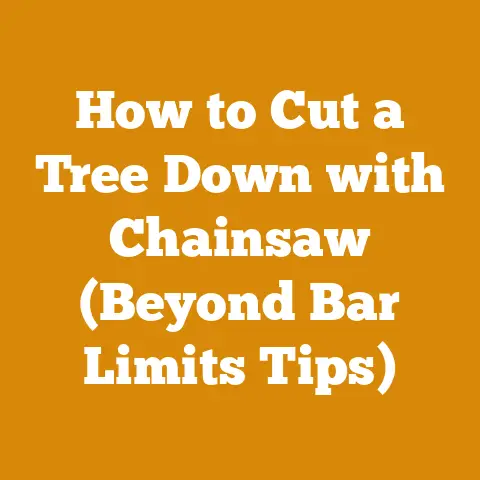Cutting Back Dogwood (5 Pro Tips for Safe Limb Pruning)
Have you ever looked at a dogwood tree, admired its delicate beauty, and then noticed a branch that just doesn’t quite fit?
Maybe it’s crossing another, rubbing, or simply dead.
Ignoring these issues can lead to bigger problems down the road, impacting the tree’s overall health and aesthetic appeal.
That’s where proper pruning comes in, and believe me, I’ve seen the consequences of both good and bad pruning practices firsthand.
From poorly angled cuts that invite disease to over-zealous trimming that leaves a tree looking butchered, I’ve witnessed it all.
Don’t let your dogwood suffer the same fate.
Let me guide you through the essential steps of safe and effective dogwood pruning, ensuring a thriving, beautiful tree for years to come.
Cutting Back Dogwood: 5 Pro Tips for Safe Limb Pruning
Dogwood trees ( Cornus species) are beautiful additions to any landscape, but like all trees, they require occasional pruning to maintain their health, shape, and vigor.
As someone who’s spent countless hours working with trees, from felling giants to carefully shaping ornamentals, I know the importance of proper pruning techniques.
These 5 pro tips will help you safely and effectively prune your dogwood, ensuring its longevity and beauty.
1. Understanding Dogwood Growth Habits and Pruning Goals
Before you even pick up a saw, it’s crucial to understand how dogwoods grow and what you hope to achieve with pruning.
Dogwoods are typically small, deciduous trees or large shrubs, known for their distinctive layered branching patterns and beautiful spring flowers.
- Growth Habit: Dogwoods generally have a naturally pleasing shape.
The goal is to enhance this, not drastically alter it. - Pruning Goals:
- Removing Dead, Diseased, or Damaged Wood (the 3 D’s): This is the most critical reason for pruning.
Dead or diseased branches can harbor pests and pathogens that can spread to the rest of the tree.
Damaged branches are a safety hazard. - Improving Air Circulation and Sunlight Penetration: Thinning out the canopy allows for better airflow, reducing the risk of fungal diseases.
It also allows sunlight to reach inner branches, promoting healthy growth. - Maintaining Shape and Size: Pruning can help control the tree’s size and maintain a desired aesthetic.
- Encouraging Flowering: While dogwoods naturally flower well, proper pruning can help maximize bloom production.
- Removing Dead, Diseased, or Damaged Wood (the 3 D’s): This is the most critical reason for pruning.
I once worked on a property where a homeowner had neglected their dogwood for years.
The tree was riddled with dead branches, and the dense canopy was a breeding ground for disease.
After a careful pruning, removing all the deadwood and opening up the canopy, the tree rebounded beautifully, producing a stunning display of flowers the following spring.
This experience reinforced the importance of understanding pruning goals and the positive impact it can have on a tree’s health and appearance.
Takeaway: Before pruning, assess your dogwood tree, identify dead, diseased, or damaged branches, and determine your goals for pruning.
2. Selecting the Right Tools for the Job
Using the right tools is essential for safe and effective pruning.
Dull or inappropriate tools can damage the tree and make the job more difficult.
Here’s a breakdown of the tools I recommend:
- Hand Pruners (Bypass Pruners): Ideal for branches up to ¾ inch in diameter.
Bypass pruners make clean, precise cuts, minimizing damage to the tree. - Loppers: Used for branches between ¾ inch and 2 inches in diameter.
Loppers provide leverage for cutting thicker branches. - Pruning Saw: For branches larger than 2 inches in diameter.
A pruning saw has a curved blade with aggressive teeth, making it easier to cut through thick branches. - Pole Pruner: For reaching high branches without using a ladder.
Pole pruners come in both manual and powered versions. - Chainsaw (Optional): For very large branches or tree removal.
Only use a chainsaw if you are experienced and comfortable operating one safely. I personally use a Stihl MS 261 C-M for most pruning jobs requiring a chainsaw due to its balance of power and maneuverability. - Safety Gear:
- Safety Glasses: Protect your eyes from flying debris.
- Gloves: Protect your hands from cuts and scratches.
- Hearing Protection: Especially important when using a chainsaw.
- Hard Hat: Protects your head from falling branches.
- Long Sleeves and Pants: Provides protection from scratches and irritants.
Tool Maintenance: Keep your tools clean and sharp.
Sharpening your blades regularly will make pruning easier and reduce the risk of damaging the tree.
I use a file specifically designed for pruning tools and sharpen my blades after every major pruning session.
Disinfect your tools with a 10% bleach solution or rubbing alcohol between cuts, especially when pruning diseased branches, to prevent the spread of pathogens.
Takeaway: Choose the right tools for the size of the branches you’re pruning, and always wear appropriate safety gear.
Keep your tools clean, sharp, and disinfected.
3. Mastering the Art of Proper Pruning Cuts
The way you make your cuts is critical to the health of the tree.
Improper cuts can lead to disease, decay, and unsightly growth.
Three-Cut Method for Large Branches: When removing a large branch, use the three-cut method to prevent the bark from tearing.
- Undercut: Make a cut on the underside of the branch, about 6-12 inches from the trunk.
Cut about one-third of the way through the branch. - Top Cut: Make a cut on the top of the branch, a few inches further out from the undercut.
Cut all the way through the branch.
This will cause the branch to break off, preventing it from tearing the bark. - Final Cut: Make the final cut just outside the branch collar.
The branch collar is the swollen area at the base of the branch where it joins the trunk.
Cutting too close to the trunk can damage the tree’s vascular system, while cutting too far away can leave a stub that attracts pests and diseases.
- Undercut: Make a cut on the underside of the branch, about 6-12 inches from the trunk.
Angle of Cuts: When pruning smaller branches, make your cuts at a 45-degree angle, about ¼ inch above a bud that is facing the direction you want the new growth to go.
This encourages the tree to grow in the desired direction.- Avoiding Flush Cuts: Never make flush cuts, which remove the branch collar.
The branch collar contains specialized cells that help the tree heal properly.
Removing it can leave the tree vulnerable to decay. - Removing Suckers and Water Sprouts: Suckers are shoots that grow from the base of the tree, while water sprouts are shoots that grow vertically from the branches.
These shoots are often weak and unsightly, and they can steal energy from the rest of the tree.
Remove them as close to the trunk or branch as possible.
I once saw a dogwood that had been pruned by someone who didn’t understand the importance of proper cuts.
The tree was covered in stubs, flush cuts, and torn bark.
It was a mess!
It took several years of careful pruning to correct the damage and restore the tree’s health and appearance.
This experience taught me the importance of patience and precision when pruning.
Takeaway: Use the three-cut method for large branches, make angled cuts above buds, avoid flush cuts, and remove suckers and water sprouts.
4. Timing is Everything: When to Prune Dogwood Trees
The best time to prune dogwood trees is in late winter or early spring, before new growth begins.
This allows the tree to heal quickly and reduces the risk of disease.
- Late Winter/Early Spring: This is the ideal time for general pruning, including removing dead, diseased, or damaged branches, thinning out the canopy, and shaping the tree.
- Summer: Light pruning can be done in the summer to remove water sprouts and suckers.
Avoid heavy pruning in the summer, as it can stress the tree. - Fall: Avoid pruning in the fall, as it can stimulate new growth that is vulnerable to frost damage.
Exceptions:
- Dead, Diseased, or Damaged Branches: These can be removed at any time of year.
- Flowering Dogwoods ( Cornus florida): Some experts recommend pruning flowering dogwoods immediately after they bloom to avoid removing next year’s flower buds.
However, I’ve found that pruning in late winter/early spring still yields good results, as long as you’re not too aggressive with the pruning.
I remember one year, I pruned a dogwood in the late fall, thinking I was getting ahead of the game.
The following spring, the tree produced very few flowers, and the new growth was stunted.
Takeaway: Prune dogwood trees in late winter or early spring, before new growth begins.
Avoid pruning in the fall.
Dead, diseased, or damaged branches can be removed at any time of year.
5. Maintaining Dogwood Health After Pruning
Pruning can be stressful for trees, so it’s important to take steps to maintain their health after pruning.
- Watering: Water the tree deeply after pruning, especially during dry periods.
- Fertilizing: Fertilize the tree in the spring with a balanced fertilizer to promote healthy growth.
I typically use a 10-10-10 fertilizer, applied according to the manufacturer’s instructions. - Mulching: Apply a layer of mulch around the base of the tree to help retain moisture, suppress weeds, and regulate soil temperature.
Use organic mulch, such as wood chips or shredded bark, and keep it a few inches away from the trunk to prevent rot. - Monitoring for Pests and Diseases: Keep an eye out for signs of pests and diseases, and take action promptly if you notice any problems.
Common dogwood pests include borers, aphids, and scale.
Common diseases include anthracnose and powdery mildew. - Wound Dressing (Optional): While wound dressings were once widely recommended, current research suggests that they may actually trap moisture and promote decay.
I generally avoid using wound dressings unless specifically recommended by an arborist for a particular situation.
I once worked on a property where the homeowner had pruned their dogwood but then neglected to water or fertilize it.
The tree struggled to recover from the pruning and eventually succumbed to disease.
This experience highlighted the importance of providing proper care after pruning to ensure the tree’s health and vitality.
Takeaway: Water, fertilize, and mulch the tree after pruning.
Monitor for pests and diseases, and take action promptly if you notice any problems.
Consider consulting with a certified arborist if you have any concerns about the tree’s health.
Case Study: Rehabilitating an Overgrown Dogwood
Let me share a story about a particularly challenging dogwood pruning project I undertook.
A client had an old, neglected dogwood tree that was severely overgrown.
The canopy was dense and tangled, with numerous dead and crossing branches.
The tree was also showing signs of disease.
Assessment: I started by carefully assessing the tree, identifying all the dead, diseased, and damaged branches.
I also noted the areas where the canopy was too dense and where branches were crossing or rubbing against each other.
Pruning Plan: I developed a pruning plan that focused on removing all the deadwood, thinning out the canopy, and improving the tree’s overall shape.
I also planned to address the disease issues with appropriate treatments.
Execution: Over the course of several days, I carefully pruned the tree, using the techniques I’ve described above.
I started by removing all the dead, diseased, and damaged branches, using the three-cut method for larger branches.
I then thinned out the canopy, removing crossing and rubbing branches to improve air circulation and sunlight penetration.
Finally, I shaped the tree to enhance its natural form.
Results: The results were dramatic.
The tree looked healthier and more vibrant, and the canopy was much more open and airy.
The client was thrilled with the transformation.
Over the next few years, the tree continued to thrive, producing abundant flowers and foliage.
Lessons Learned: This project reinforced the importance of careful assessment, a well-thought-out pruning plan, and precise execution.
It also demonstrated the remarkable resilience of dogwood trees and their ability to recover from even severe neglect.
Common Mistakes to Avoid
Here are some common mistakes I’ve seen people make when pruning dogwood trees:
- Over-Pruning: Removing too much of the tree’s canopy can stress it and make it more susceptible to pests and diseases.
A good rule of thumb is to never remove more than 25% of the tree’s canopy in a single pruning session. - Topping: Topping is the practice of cutting off the tops of trees, leaving unsightly stubs.
This is a harmful practice that can damage the tree and make it more prone to disease. - Using Dull Tools: Dull tools can tear the bark and damage the tree.
Always use sharp, well-maintained tools. - Pruning at the Wrong Time: Pruning at the wrong time of year can stress the tree and make it more susceptible to damage.
- Ignoring Safety Precautions: Always wear appropriate safety gear when pruning, and be aware of your surroundings.
Advanced Techniques for Dogwood Pruning
For those with more experience, here are some advanced techniques that can be used to further enhance the health and appearance of dogwood trees:
- Crown Reduction: This technique involves reducing the overall size of the tree’s canopy by selectively pruning back branches to lateral buds.
It’s often used to reduce the risk of storm damage or to improve the tree’s appearance. - Cabling and Bracing: These techniques involve using cables and braces to support weak or damaged branches.
They’re often used to prevent branches from breaking under heavy snow or wind. - Grafting: Grafting is a technique used to propagate dogwood trees or to improve their resistance to disease.
It involves joining a scion (a piece of a desired tree) to the rootstock of another tree.
Final Thoughts: Nurturing Your Dogwood for Years to Come
Pruning dogwood trees is an art and a science.
By understanding the principles of proper pruning, using the right tools, and following these pro tips, you can help ensure the health, beauty, and longevity of your dogwood for years to come.
Remember to always prioritize safety and to consult with a certified arborist if you have any concerns.
With a little care and attention, your dogwood will continue to grace your landscape with its delicate beauty for generations.






